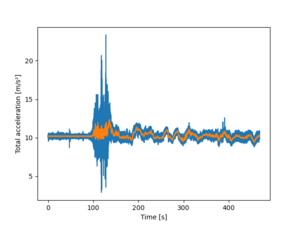Python and phyphox: Difference between revisions
| Line 70: | Line 70: | ||
</syntaxhighlight> | </syntaxhighlight> | ||
will give the legend box. | will give the legend box. | ||
It is clearly shown that the something happens about at t=96 s; the acceleration changes from a bit over 10 to something else. However, even the smoothed data is rather difficult to visualize what happens. | |||
=== 1. Departure WAW-TLL: Check the Rolling mean === | === 1. Departure WAW-TLL: Check the Rolling mean === | ||
Revision as of 11:15, 11 June 2025
Introduction
Phyphox XML and VIM
Activate the matchit.vim macro :runtime macros/matchit.vim and set the filetype :set filetype=html (or xml), and now % swaps between the tags.
The data is located in <data-containers> blocks and <container> tag contains the data of each measurements, but is in init tag, as shown below: <container size="0" init="1.009771156E1,1.012672424E1,1.004746246E1,1.009292603E1,1.024636555E1,1.024875832E1,1.015065289E1,1.007617569E1,1.012193871E1,1.011954594E1,9.999606133E0,9.978070259E0,1.0059426. Thus, we need to read the init part only.
Load the acceleration data
The simplest
import pandas as pd
df = pd.read_xml( filename )
does not work if the XML file is too large. Use lxml from etree instead:
from lxml import etree
def parse_lxml_large_xml(source, a):
for event, elem in etree.iterparse(source, events=('end',)):
if elem.tag == "container" and elem.text == a:
#Split the string and convert to float
A = elem.text
B = elem.attrib
BB = B.get('init').split(",")
data = np.empty( (len( BB ), 1 ) )
for i, d in enumerate( BB ):
data[i,0] = float(d)
elem.clear() # Free memory
return data
and use it as
accX = parse_lxml_large_xml( "nousu_waw_tll_edited.phyphox", "accX" )
accY = parse_lxml_large_xml( "nousu_waw_tll_edited.phyphox", "accY" )
accZ = parse_lxml_large_xml( "nousu_waw_tll_edited.phyphox", "accZ" )
acc = parse_lxml_large_xml( "nousu_waw_tll_edited.phyphox", "acc" )
time = parse_lxml_large_xml( "nousu_waw_tll_edited.phyphox", "acc_time" )
A = np.column_stack( [time, accX, accY, accZ, acc] )
df = pd.DataFrame( A, columns=['time', 'ax', 'ay', 'az', 'a'] )
df.set_index('time', inplace=True)
The last line changes the time column to be the index column, and the inplace keyword replaces that data directly into df variable.
We can load any other data similarly, too. Just change the the names in function calls.
Flights
1. Departure WAW-TLL: Plot the data

ax = df.a.plot()
ax = df.a.rolling(window=100).mean().plot(x='time')
ax.set_xlabel('Time [s]')
ax.set_ylabel("Total acceleration [m/s²]")
The rolling(window=100).mean() calculates the rolling mean with a window of width 100 to be plotted. The x='time' in parenthesis is not obligatory, as we already stated that the index is time. The last two lines are to state the x and y labels better.
The command
ax.legend(['All data', 'Rolling mean (100)'] )
will give the legend box.
It is clearly shown that the something happens about at t=96 s; the acceleration changes from a bit over 10 to something else. However, even the smoothed data is rather difficult to visualize what happens.
1. Departure WAW-TLL: Check the Rolling mean